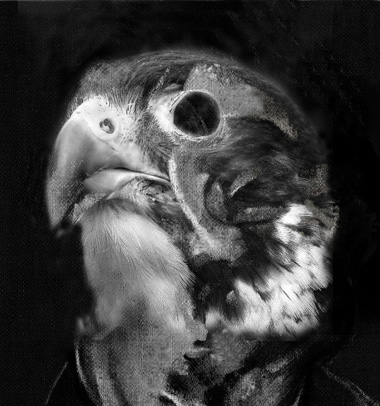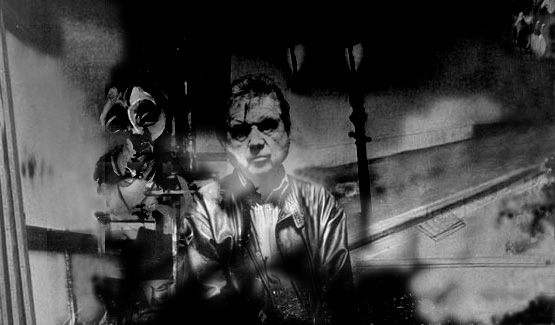
Though we start in the shadows, we’re making for the light – Sian Aeschylus O’Neill
Scene I
The Image-maker at work:
It’s a black sky beyond the horizontal road – a dustgrey road streaked with olive. Black sky, or perhaps a wall. Am I getting it all wrong? Rub the eyes, try again… It’s a black wall. On the bloodred wall-to-wall carpet a dustgrey mat with a faded black grid. And on the mat scrubbed in shadow and stark white sits an imperial sphinx. There’s no door, unless it’s behind me. There’s no window, unless it’s miles above. A touch of Yeats, perhaps. Some kind of gloomy funereal joke. Only the head has much substance, though the features are slurred. Am I drunk? Is this what I meant to do? Why is it I know so little? I start out with a sure touch, a steady hand, a clear sense of the job in hand. There’s even a plan of sorts. Nothing on paper of course, but clear enough in my head. That’s the scene at dawn. But by noon the trouble’s started. Decay sets in. The message scrambled. And by evening here I sit as dark as a Mongolian tomb. What blindness stalks me, ever-ready to pull the rug from under my feet? And as the sun goes down out there so does the shadow extend across my brain. The great paw flicking dust in my face. So there it is. Unfinished. Little more than a painter’s shuffle. Why can I never get to the eyes? Why is the mouth such a distance? And, Yeats be damned, why is the sphinx’s shadow a gunman’s silhouette?
*
On the desktop beside a grey typewriter is a photograph. Head and shoulders of a man. Side-view. Black and white. The profile of a dishevelled eagle. Eye without mercy. Brow flexed in a ripple of permanent curiosity. Yet, at the same time, a hint of weariness, a surgeon’s controlled disinterest. And what is it he sees without blinking? What have his talons frightened into revelation? The body as a writhing muscle? Many kinds of hunger? Endless faces of vanity masked and unveiled by doubt? Passion endlessly scrubbed by time?
Beneath the photograph, a black catalogue of his many works: image after image, at once ascetic and sensuous, pigment attacking the shadows of reality like a stake through a virgin’s heart.
Beside the photograph, the catalogue and the grey typewriter is an old paperback. Dirty, well-fingered, smudged with pigment and affection. It is the tale of Agamemnon, ancient king returning to his wife after years of war. She waits for a sign of his arrival. When he eventually comes to her, travel-worn and dust-covered, slave-girls have prepared a fragrant bath for him. As he climbs out of his bath his wife throws a net over him, rendering him helpless as she and her lover kill him with sword and axe.
*
IMAGE: his own – a self-portrait. Pale violet canvas, black border, figure on a chair or stool, a glimpse of wicker, legs crossed in a flamboyant heel-in-the-air gesture, head wrestling with its own convoluted flesh, a hat, maybe, squandered on the eagle’s crest, hands in trenchcoat pocket as lost as coins in a wishing well, buttons like badges of office, buttonholes like bullet holes, a fever gripping grey flannels, allowing the legs no rest….
IMAGE: ankle turning into a foot that never ends….
IMAGE: doors opening on to forbidding black space….
*
Everyone complains about violence. Gratuitous they say. And, of course, there is always a delicate violence to the jab of truth. But there’s lyricism as well, a lush newborn flavour to the pigment, rose-pink turning to salami….
*
He carries on working:
Come on, cut it out. Who gives a toss? Another drink would open up the chat, give us some air. You know I’d always thought we spoke the same language – but it’s like listening to Mozart in the rain. Yes, Mozart. I like the poor sod. OK, he died under a cloud. Too much mystery for my taste. None of the light I see in this drink or in his music. But really, no more. Shut up for a while. Listen to the whispering muse.
Surely you can see it’s the steady plough of brush on surface that yields the image. All those slightly hazy nights of changing forms, lightening a touch on the leg, darkening an eye. And the sensual dance of colour – a constant temptation towards excess. This is the passion, the fun and the drudgery.
Drink some more of the seeing, the glass dispersing light to all corners.
No sooner is one picture finished than another starts pressing its nose against the brush. Demands. Obligations. The necessity to try once more. Perhaps this will be it. The big one. Hitting the bull. A succession of sixes. Who knows?
And the dust and filth on the floor, that’s my shedded skin, smeared and grimy, slick of years over everything. There was a time when I indulged in the crap that gets talked about. A rationale for each mark. A reason for every drip. Even a master plan. Not anymore. Now it’s just me and the tube and what’s in it and how I can push it here and there. Nothing more. Just the pressure of fingers, a turn of the wrist, a battered old hoghair and the occasional drink. Only as much thinking as a brush does, as the fingers bequeath to a surface.
Sometimes I wait for an image to emerge, to alight here like a bird’s shadow on the tiled roof opposite. I often wait in vain. Hours go by, days and nights, long seasons of drink and frustration, hopes subsiding into false dawns. But eventually I see what was not there before and I realise my waiting is also a conjuring, a bringing forth, a making. Out of the fallowness of waiting a sign makes itself and I only have to be awake to see it. Sometimes it’s there and then it’s gone and no matter how hard I try I can’t bring it back.
Anything smells of roses on a gallery wall, with an expensive receptionist and a telephone preaching long distance. But for me something is lost when they leave this pokey hole. Don’t know why. It’s been the same for years. I can stand to have them here, propped up against the spattered walls, moist, well-fingered. I even think, at times, they’re OK. One or two. Occasionally. But when they’re carted off to the white-walled purgatory, treated like expensive furniture, perfumed, de-loused, gilded, gelded….they shrink, lose something, diminished every time someone looks at them. Sometimes, just before one’s due to be packed up, I come in here and slap it with a two-inch housebrush. Black, white, whatever’s at hand. I don’t even look. Just walk in, pick up the brush, dunk it in and bang it on. One stroke, never more. Then I flick off the light and go to bed. By the time I’m up it’s gone. Loaded on to a van like a Steinway. I don’t see it again until it’s the centre of some little discussion at a preview. Drink in hand, a coiffured gent says: It’s the energy of the one white brush-stroke that gives it such menace, my dear, what a coup-de-grace! What bullshit.
*
IMAGE: another self-portrait. Quasimodo clown. Lips pursed. A funny face to remember as you flick off a TV show. Even the same no-nonsense, full-square, face-in-a-box routine. Close-up. Putty features. It’s more of a shock than the others. The face of the comic when you’re expecting a death’s head.
Scene II
In some other place, at a time undecided, a king has been away too long. When he returns to his wife she will kill him. On the roof of his palace a figure waits for a sign that will tell him the king is coming. He has waited a long time.
The Watchman: four whole seasons it’s been. Night after night like a dog I’ve lain on these tiles eyeing the horizon, reading the black sky. They said it wouldn’t be long, he’d be back soon, but moon followed moon without a sign. Some nights I’d lie shivering, get up, walk about, bury myself under a sheepskin, run like a madman from wall to wall – but I couldn’t escape the cold. Even in afternoon sunshine I would sometimes shiver, still in the shadow of a long night. And when the darkness grew short, long after I’d drunk my supply of water, I’d stand naked savouring the whisper of a breeze. Heat and cold. Sweat and numbing frost……. But what’s that? A new star? So often I’ve scrambled to my feet only to find it’s nothing special. The same stuttering lights deceiving my sleepless brain. And often the dew on my eyelashes is the culprit, multiplying stars….. But tonight I’m dry. The air is clear. And that star is a stranger, lower than all the others, brighter. But I must be sure before I send word.
Scene III
IMAGE: three in a row: headless bird hung by a wingtip, caged like an imperial eagle, life’s departing fury spitting blood at the gallery walls; the neck of a headless man pointing its backbone towards us; a slave’s empty skin.
Scene IV
The Watchman: four seasons I’ve kept my vigil like a dog on these tiles and like a dog I’ve slept through the busy day and I’ve seen much and heard more. I know as much as anyone about horizons and stars and expectations defeated. There’s nothing you can tell me that would bring surprise. The geography of darkness is as familiar to me as the hand with which you write. But I will not speak, let alone howl my protest. The King will know soon enough how things are. These stones will do my barking for me.
Scene V
The Palace speaks: his tongue may be nailed down but mine’s not, my walls will voice what the Watchman daren’t. Each of my rooms will tells its tale. Each door opening on to darkness speaks loud enough for the King to hear, for him to see what awaits him.
Scene VI
The Image-maker starts again – his brush flickering blindly in a labyrinth of stars.
Scene VII
Closing the catalogue of dark signs I put away the photograph. Night has fallen. I can see only my own faint reflection in the window before me. Nothing of the garden remains – though I know when I open the door and step out into the shadows I will pass between bushes and walk on wet grass…. as the Image-maker always waits for a sign and the Watchman always waits for a King who always comes to die again and again….

Note
This text was written sometime in the 1980s and slightly revised in 2009. The photo montages are made by the author.
There is no obvious connection between the image-making painter and the watchman ordered by Clytemnestra to look for the beacon that will tell of Agamemnon’s return. And yet, perhaps there is. Francis Bacon may have been the image-maker, his paintings the pretext for this scrap of narrative. No matter how hard I search I can find nothing about Sian Aeschylus O’Neill.